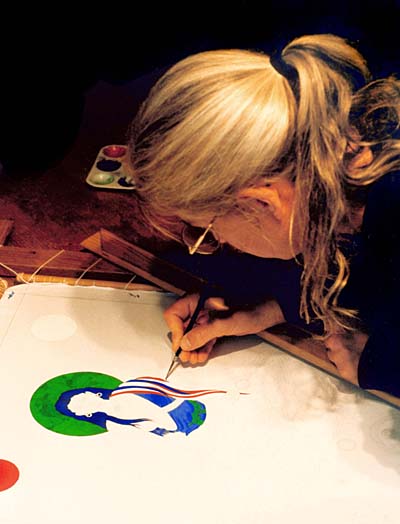
Thrinlé Khandro
thankga painting student of Khandro Déchen
As a teenager I wanted to be a botanical illustrator. Unfortunately I was good at science exams so I got into medical school instead. It was really interesting, to discover the way in which bodies work – but the exams became more difficult and I had to leave.
I spent the next twenty years working, learning new crafts and being a mother. Apart from being a mother there was never anything I felt I really wanted to pursue with a passion, though I always found it exciting to learn new craft skills.
I worked with children and people with learning difficulties. I taught classes and held workshops, organised projects, catered for large numbers and sold my handmade items. I thought I’d be a weaver—then a potter—and I was for a while, but then moved on to something new. After fifteen years of this, something needed to change. Having read their books, I set out to look for Ngak’chang Rinpoche and Khandro Déchen, and was fortunate enough not only to find them, but also to be accepted as an apprentice.
I have been studying thangka painting with Ngak’chang Rinpoche and Khandro Déchen for four years. At first I simply thought it would be interesting to experience a thangka painting retreat, but I soon began to feel that Vajrayana imagery and painting was something that I wanted to pursue with far greater seriousness than anything I had attempted before.
The richness of the colours, images and symbolism is amazingly inspiring. The colours used in Ngak’chang Rinpoche and Khandro Déchen’s style of thangka painting are particularly vibrant and the lines clear and beautiful. Everything depicted on a thangka has a meaning, and learning the meaning of the images and symbols is—for me—the best way to remember teachings. An example of this is the high degree of attention which is paid to the symbols portrayed. The thangka is simple in composition, which allows the symbols shown to be shown precisely: every bead of the human bone cemetery ornaments is an individual outlined circle. The offerings of the conches and long-life arrows are also completely precise – showing the male and female forms of the arrow flights as the progression of elemental colours from emptiness into form and from form into emptiness.
Thangka painting has many aspects. Canvas preparation, drawing, painting, airbrushing. All of these are challenging, and as a beginner they seemed impossibly daunting to me. Ngak’chang Rinpoche and Khandro Déchen are so encouraging and patient, keeping me optimistic while my first efforts were so clumsy and untidy.
It has been a long process to be introduced to this craft. The first year I worked on line drawing – tracing, enlarging, adapting and building up images. The next year I was lucky enough to be given the job of painting a vajra and lotus in each of the five colours – a painting exercise with a use as well. The next year I worked on more line drawings; designs for transfers for treasure vases. With Ngak’chang Rinpoche’s constant correction these were eventually completed successfully.
At each stage of learning I felt that my understanding of the teachings has deepened. I see the elements in the things around me, appreciate the beauty of form and colour in what I see.
Last year I began to feel impatient. I wanted to start a thangka. Khandro Déchen suggested I start painting from a line drawing she had already completed of A-yé Khandro. An uncomplicated image with which to begin.
This first thangka is finished now. I can see so many mistakes in it that I would never dare to give it to anyone but now I’m started on my second I feel more confident. This confidence comes to me from my teachers whose encouragement keeps me wanting to improve and progress. I know I am extraordinarily lucky.
I love the precision of the craft. Attempting perfection in every brush stroke or pencil line. I love the vibrant colours, sharp-edged contrast or gentle shading, dark to pale. There is never a step in the process where less than my best is good enough. It’s always worth making the effort, taking the trouble to work as well as possible, 100%. A good lesson for daily life.
I recently trained to be a Steiner school teacher and now I have a busy full-time job. I am still a thangka painter, though it is difficult to fit everything in. Twenty-five years on from my early aspirations, I now want to be an illustrator of symbol in the Aro gTér lineage. It is so important to have these inspirational images and if I can ever be a good enough painter to help in the making of them, I will be extremely happy. Certainly the process of learning is exciting, challenging and amazingly interesting. My boundless thanks to my teachers for bringing me this far.
